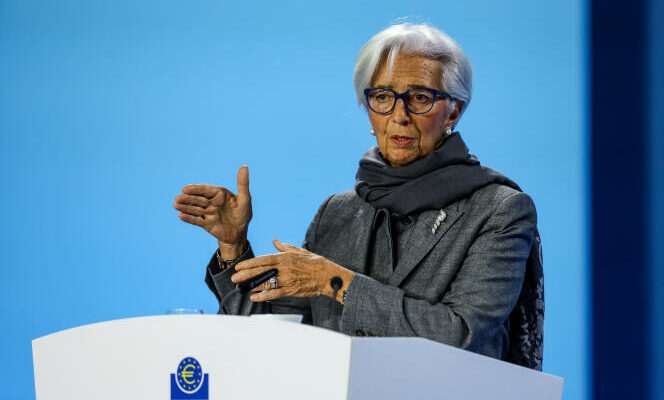Following in the footsteps of other major central banks, the European Central Bank (ECB) extended the status quo on its key rates on Thursday, December 14. Its president, Christine Lagarde, however tempered expectations of a rate cut, warning that it was necessary “don’t let your guard down” despite the sharp decline in inflation in the euro zone.
The main key rate remunerating deposits, the benchmark for credit in the euro zone, was thus maintained at its historically high level of 4%, which it had reached in September. While the cycle of drastic rate increases seems to be coming to an end for the main monetary institutions, the question now arises of the moment which will be chosen to ease the constraint.
Mme Lagarde assured the press that the board of governors had not “not discussed at all about rate cuts” during its monetary policy meeting on Thursday. She notably mentioned the inflationary risks linked to ” wages “to “geopolitical risks” and to “extreme weather events” which can push prices up.
A forecast price increase of 2.7% in 2024
“The slowdown in underlying inflation [hors prix volatils d’énergie et des matières premières] continued » since October, but “price tensions remain sustained, mainly due to dynamic growth in unit labor costs”underlines the institution in its press release.
However, the ECB no longer believes that inflation will “always stay too strong for too long a period of time” with regard to its objective of 2%, according to the formula which has been repeated since September 2022. The press release of monetary policy decisions does not, however, provide any indication of an upcoming relaxation of rates.
Quicker to foresee such a reversal, the American central bank (Fed) “discussed a timetable for rate cuts” Wednesday, said its president, Jerome Powell, after leaving rates unchanged for the third time in a row.
Inflation has led the ECB to ten consecutive rate hikes since July 2022, until a first pause came into force in October. This increase in prices in the euro zone has been divided by more than four since the record of 10.6% reached in October 2022, when the effects of the war in Ukraine on gas and oil prices were fully felt.
In its new forecasts, unveiled Thursday, the monetary institute forecasts an increase in prices of 2.7% in 2024, compared to 3.2% previously, then 2.1% in 2025 and 1.9% in 2026. Growth projections were also revised downwards for 2024, to 0.8% in 2024, compared to 1% in September, then set at 1.5% in 2025 and 2026.
Le Monde Buying Guides
Reusable water bottles
The best water bottles to replace disposable bottles
Read
The tightening of monetary policy has increasingly visible consequences on the economy: the increase in the cost of credit weighs ever more heavily on businesses and households, particularly affecting real estate.
Several central banks maintain their monetary course
The ECB wants to maintain high rates as long as necessary, because it fears a new surge in energy prices against a backdrop of geopolitical tensions, particularly in the Middle East. She is also worried about wage increases which could fuel a rebound in prices. The ECB has also announced that it intends to accelerate the reduction of the balance sheet of debt acquired during the years of low inflation and Covid-19.
The institute will only reinvest half, i.e. 7.5 billion euros per month on average from July 2024, i.e. six months earlier than planned, the debt acquired as part of the emergency plan against pandemic (the PEPP) launched in 2020. These reinvestments will stop at the end of 2024, according to a press release.
Other central banks decided on Thursday to maintain their monetary course: the National Bank of Switzerland did the same, maintaining its main rate at 1.75% while inflation, which fell to 1.4% in November, remains below monitoring.
Also capping a turbulent year, the Bank of England left its key rate unchanged at 5.25%, judging that inflationary pressures persisted, and that rates were likely to remain high “over a prolonged period”.
The Central Bank of Norway, noting that inflation remains too high, raised it for the fourteenth time in more than two years, from 0.25% to 4.5%. But she plans to keep it at that level ” for a certain time “.
